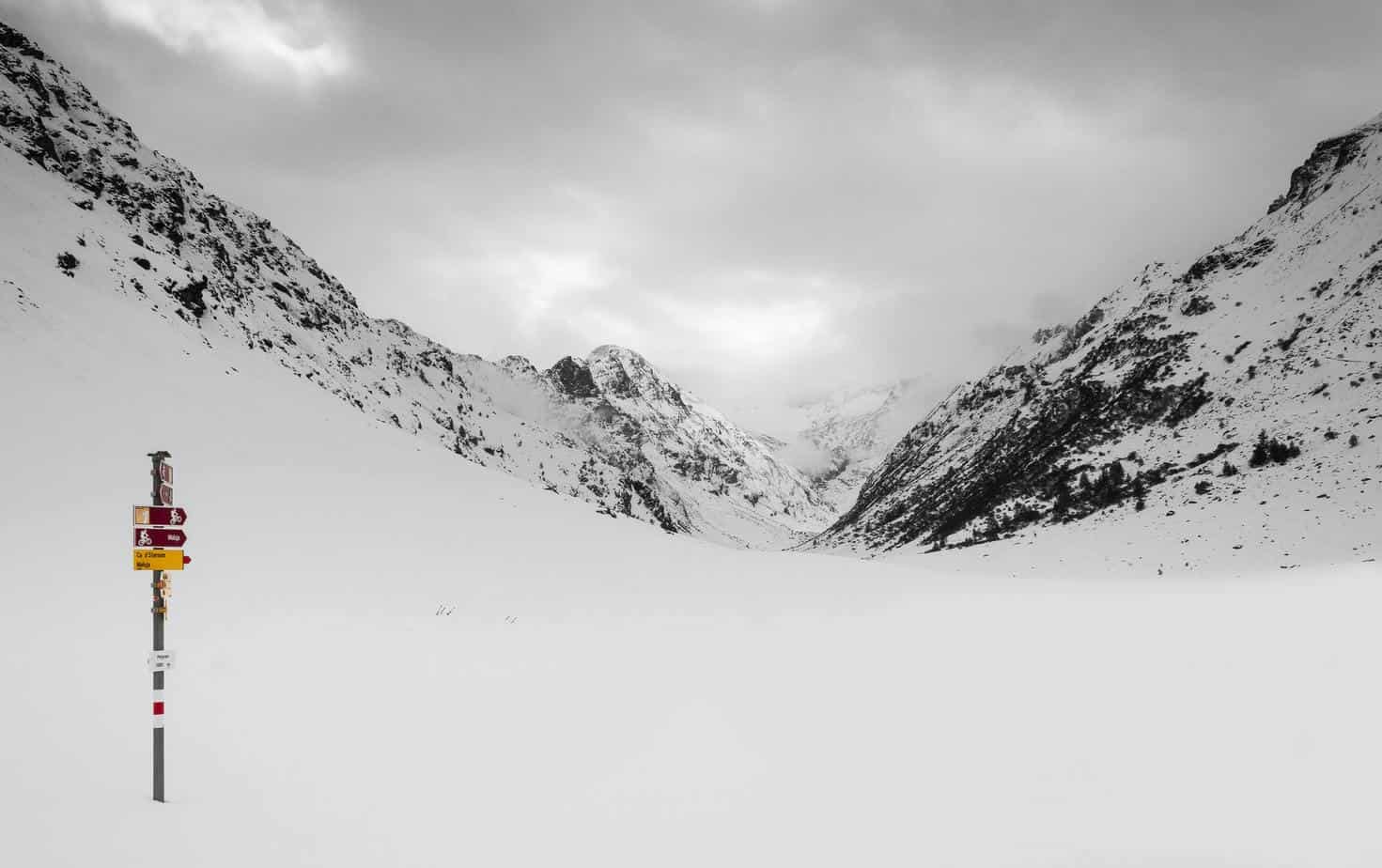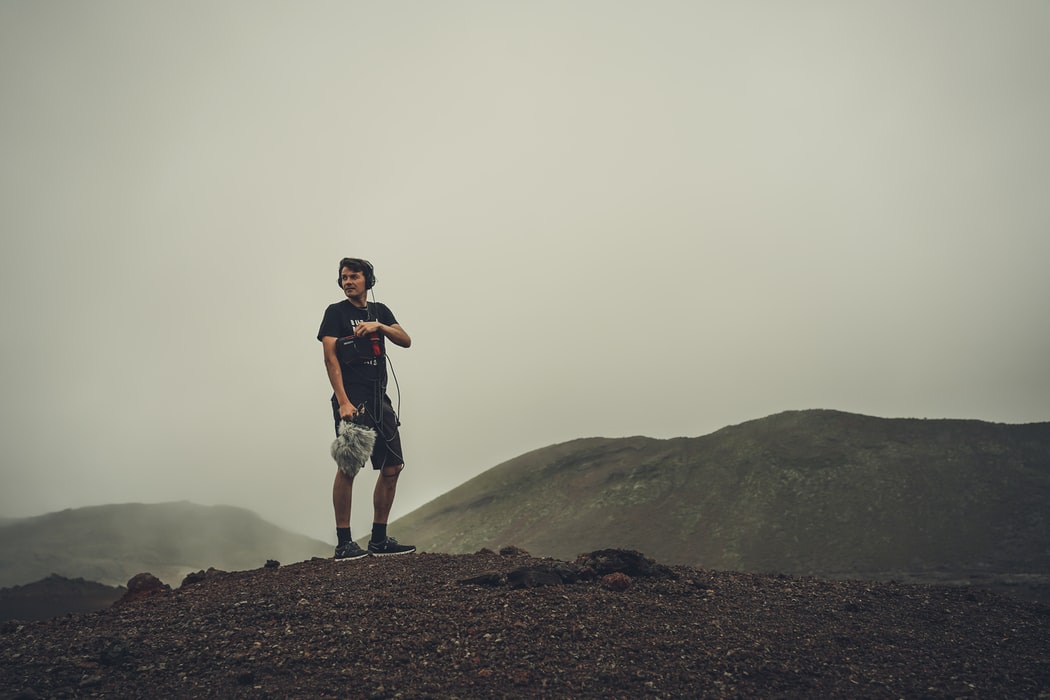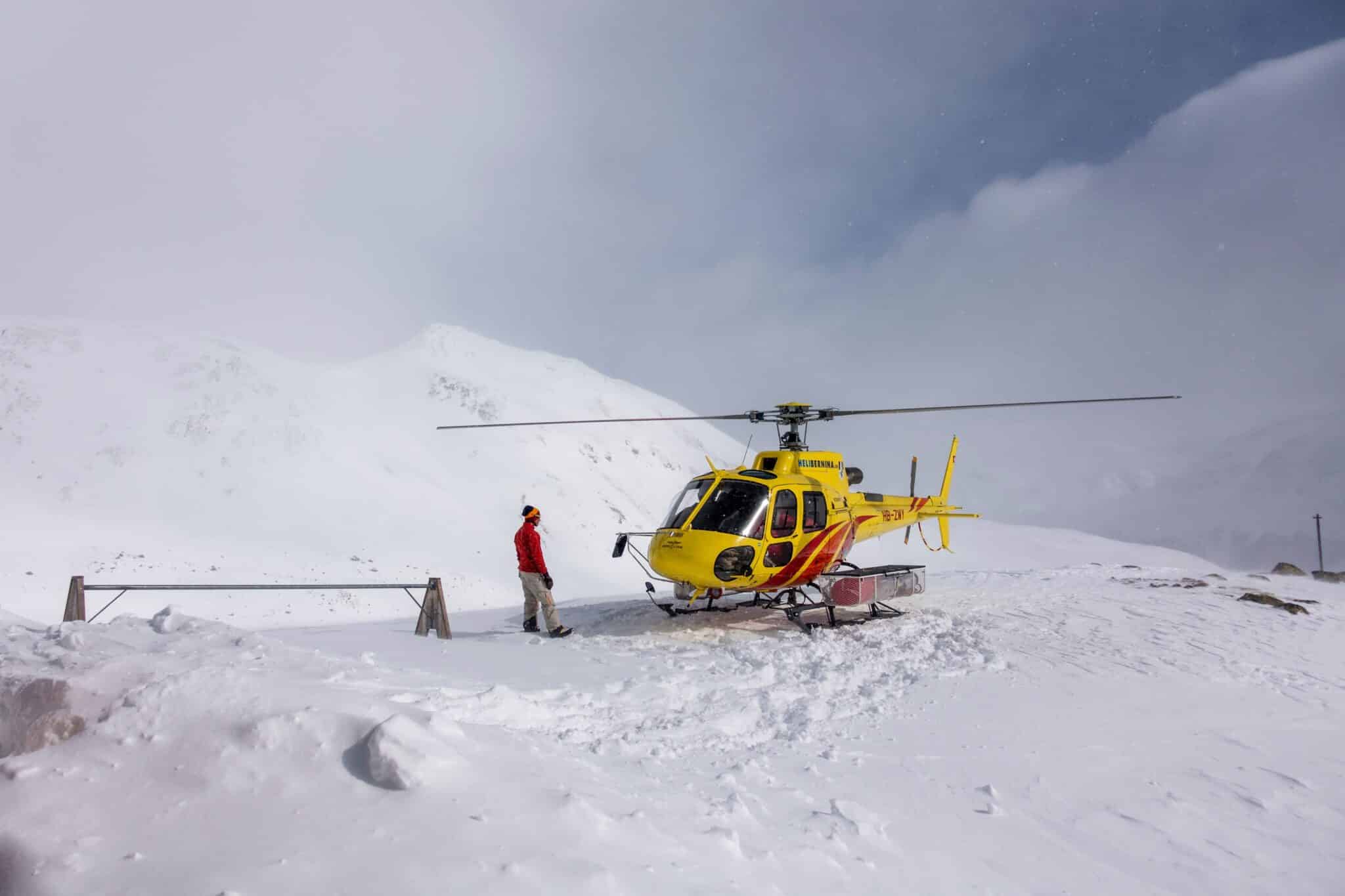Winter adventures are anything but ordinary. Winter brings a fresh perspective to exploring that you just don’t get in summer. Having to take extra precautions is one of the biggest ways that winter adventures differ from summer.
There are seven fundamental things we think you should take into consideration before exploring frozen waterfalls and icy trails:
- The weather and wind chill
- Recognizing signs of frostbite and hypothermia
- Function over fashion
- Checking your gear
- Go with a guide
- Assess your physical condition
- Nutrition and hydration
1. Check the Weather and Wind Chill
Weather
The first thing you should do before going out is to check the weather and the wind chill. Not only do you want to see what the weather will be like when you’re starting out, but you want to see what’s expected in your destination.
This is especially important if you’re traveling far or hiking to a higher elevation. The weather may be mild at your point of origin, but your destination can be completely different in terms of conditions.
Don’t forget to take note of the time the sun sets. Especially in winter, temperatures drop a lot faster once the sun goes down.
Wind Chill
Wind chill differs from the weather in that it is how cold we feel when we’re outside. It’s based on “the rate of heat loss from exposed skin caused by wind and cold.” In other words, it may be 40°F outside, but if the wind is blowing, it could feel like 20°F.
A more drastic example Weather.gov uses is “If the temperature is 0°F and the wind is blowing at 15 mph, the wind chill is -19°F. At this wind chill temperature, exposed skin can freeze in 30 minutes.”
Checking the weather, sunset time, and the wind chill before going out could be the difference between a fun adventure and a dangerous one.
2. Recognize Signs of Frostbite and Hypothermia
Being able to recognize the signs of frostbite and hypothermia could save your or your friend’s life, or earlobe. Thanks to the Centers for Disease Control and Prevention and the National Institute for Occupational Safety and Health (NIOSH) for this informative sheet:
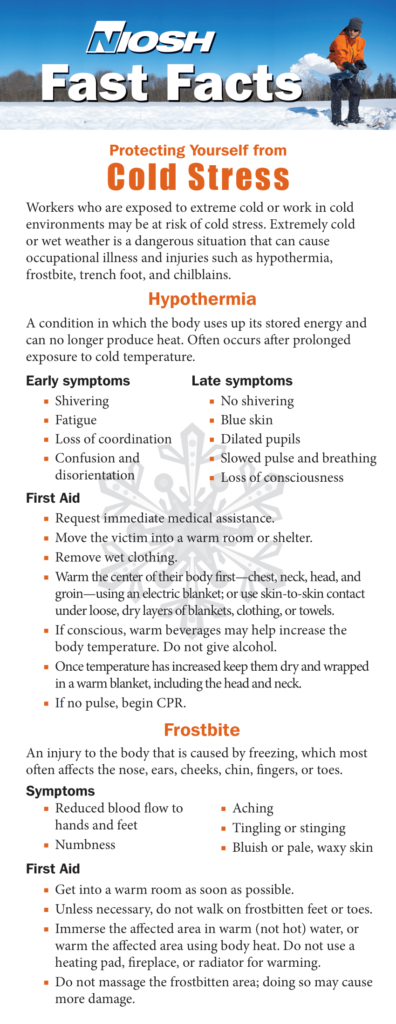
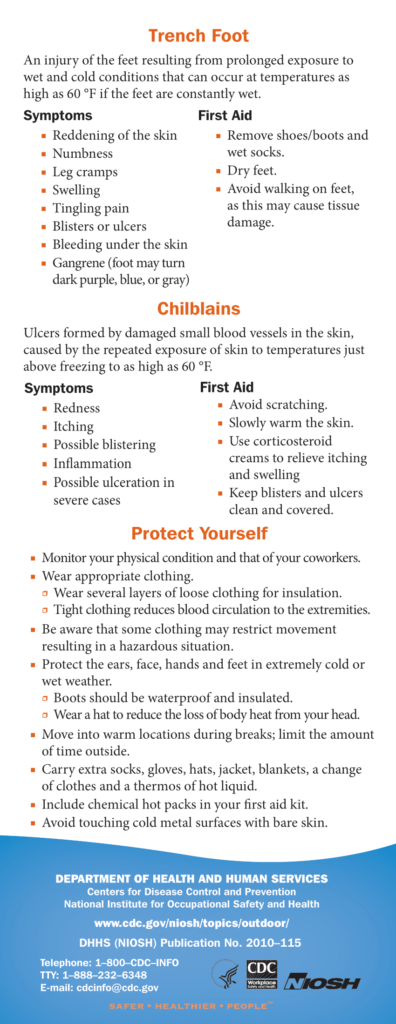
As adventurers, we have a high risk of developing frostbite or hypothermia because we spend a long time outdoors and we’re usually trudging through snow. Knowing when and how to spot either is important for anyone exploring the outdoors during winter.
3. Winter Attire: Function Over Fashion
Those who go on winter adventures will typically choose function over fashion. For us, it’s more important to wear clothing that protects us than to make us look good. For winter, especially, layering will be your best defense against hypothermia or frostbite. And avoiding cotton.
Layering
REI has a great article for dressing in cold weather. In it, they describe the three layers you need to protect yourself to stay warm and dry: 1. Base layer. 2. Middle layer. 3. Outer layer.
Base layer
The base layer needs to keep you dry. As you saw in the info sheet from the CDC, being wet exposes you to frostbite and hypothermia a lot faster than being dry. It’s important to find a base layer made of either wool or polyester that fits snug enough to wick moisture away from your body to the surface of the material.
Middle layer
This layer insulates your body and keeps you warm. This layer will really depend on the adventure you’re going on. For example, if you’re going ice fishing, a down jacket will be perfect because you aren’t moving or working up a sweat. Alternatively, if you’re going on a sweat-inducing adventure, you’re better off using a jacket made with synthetic fibers.
Outer layer
Finally, your outer layer is the shell that protects the other layers (and you) from snow, rain, or wind, or a combination of the three. You want a jacket that’s waterproof, not just “water-resistant.” “Water-resistant” is a fancy way to say that you may still get wet. You also want a jacket that’s breathable because if there’s no place for the inside moisture to go, everything will end up damp — the same with your body.
Keeping Your Extremities Warm
We can’t forget your head, hands, and feet. And as with the layers, avoid cotton. Wearing cotton is like wearing a giant sponge. This is what REI suggests:
Head
Opt for hats that cover your head and ears and are made with wool, fleece, polyester, nylon, or fur. And if you need to protect yourself from rain or sleet, using your outer jacket’s hood will work. To protect your face and neck (and the carotid artery), use a balaclava.
Hands
The best option is to find gloves that are breathable and waterproof. Just like layers, these kinds of gloves will help wick away moisture and at the time, prevent it from coming in.
Feet
Your choice of footwear will heavily depend on the conditions you’re trekking through. If you’re walking through cold but dry areas, good traction boots with wool socks will do just fine. If your conditions are wet and cold, then you need waterproof boots with wool socks.
The most important thing to remember is that you want to keep your body warm and dry. Materials like wool, down, and synthetic fibers will do that job. Cotton won’t.
Like what you’re reading? Sign up for our newsletter and receive product updates, blog posts, and more:
[hubspot type=form portal=20710242 id=18ac1a5f-a560-4d2e-a134-9654342f7b61]
4. Check and Repair Your Gear
Next to wearing the right clothing is making sure your gear works properly. The last thing you want during a winter adventure is for any of your gear to fail. Like they say, “An ounce of prevention is worth a pound of cure.”
Taking the time to check all of your gear for any wear and tear or malfunctions will help you avoid any safety issues during your trip.
A quick list
The gear you check will depend on the adventures you’re going on, but here’s a general list of things to inspect before hitting the trails:
- Check seams of your clothing and gear for any snags, puckers, or wear.
- Find any broken zippers or holes.
- Make sure you have fuel for cooking.
- Check on anything that uses batteries.
- Look at your First Aid Kit and replace anything missing.
- Count your tent poles and stakes.
- Check straps, buckles, and buttons and make sure they all latch.
Backpacker has made it really easy for all of us. They have a page dedicated to gear repair for everything from repairing a liquid fuel camp stove to repairing hiking boots.
5. Go With a Guide
The next biggest thing is to make sure you tell someone where you’re going and when you expect to return. Also, give your contact a plan in case they don’t hear from you by the time you told them. This helps prevent a 127 Hours situation.
Another way to prevent a 127 Hours episode is by going with someone. Better yet, go with a guide. We previously wrote a post about why you should explore with an outdoor guide. Going on a winter adventure with a guide means you’re going out with an expert.
You don’t have to worry about getting lost in a blizzard, showing up to an ice fishing spot with no fish, or wasting time navigating different trails. Outdoor guides can give you proper instruction whether that’s learning how to snowboard or refresh your skills to climb up a frozen waterfall.
6. Assess Your Physical Condition
Winter adventures (okay, all adventures) require you to be in good physical shape. Not only for safety but for an enjoyable experience. You need strong muscles to lift yourself over obstacles, carry a heavy backpack, and the endurance to trek several miles.
Be honest with yourself and what you can handle. Check with your doctor to make sure you’re healthy enough to test your limits. It’s always a good idea to start small and work your way up. Start with hikes close to home before tackling a 14’er in the dead of winter.
We published a guide to getting in shape for hiking from home and an interval workout for cyclists that isn’t on the bike. These are great places to start. Having a regular fitness routine will help prevent injuries and reduce fatigue when you’re out on the trail.
7. Nutrition and Hydration
Last but not least is making sure you’re on top of your nutrition and hydration when you’re out on a winter adventure.
Hydration
Baylor College of Medicine says if you’re thirsty, you’re already dehydrated. Before you even set out, you want to be hydrated. They list signs of dehydration:
- Excessive sweating
- Thirst
- Decreased urine output or darkly colored urine
- Headache
- Fatigue
- Cramping
- Dizziness
To avoid dehydration, drink at least 16-20 ounces of water before going on your adventure. While you’re out exploring, you need to drink 6-12 ounces of water (with electrolytes) every 10-15 minutes. Then you need to replace whatever you lost during your activity, usually 16-24 ounces of fluid.
Don’t forget about insulation. Water freezes in the winter. Don’t get stuck with an ice cube.
Nutrition
When you’re backpacking, hiking, fat biking, or snowboarding, you’re burning calories. A lot of them. And you need to fuel your body for it to perform. Eat Right Nutrition, a nonprofit organization that provides healthy eating tips from registered dietitians, has several tips for campers and hikers (and everything in between):
Plan
Plan your nutrition and hydration before your adventure. Some things to consider are the length of your trip, how much you plan to carry, how you’ll eat and drink, and what utensils you’ll need.
For a brief adventure
Choose non-perishable, lightweight, and nutrient-dense foods. They list:
- Trail mix
- Fruits and vegetables that don’t need refrigeration
- Nuts and nut butter packs
- Energy or granola bars
For shorter adventures, you want to eat something that will provide you with sustainable energy throughout your activity.
For a multi-day adventure
Longer trips require more planning and more food. Besides the foods above, you’ll want:
- Ready-to-eat cereal
- Canned goods (fish, poultry, or meat) in individual servings
- Dried soups and dehydrated foods like whole-grain pasta, couscous, rice, hot cereal, etc. (you’ll need to boil water)
Providing your body with enough protein after your outing helps prevent muscle breakdown. Even if you’re completely exhausted from that 14’er hike, get a good balance of carbs and protein afterward.
Every body is different, so it’s good to know what your stomach can and can’t handle before going out lest you get stuck digging a cat hole.
Whether you’re setting out on your first winter adventure or your 100th, preparation is key. Ensuring you’ve checked the weather and wind chill, knowing the signs of frostbite and hypothermia, dressing for function, not fashion, inspecting your gear before using it, exploring with a guide, assess your fitness, and staying hydrated and well-nourished will make for an epic (and safe) adventure.

